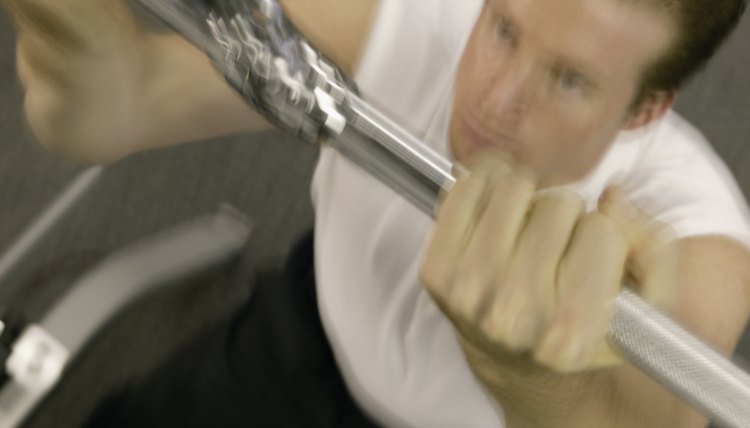Which Muscles Are Concentric & Eccentric in a Chin Up?

Performed with a variety of hand grips and sometimes with the help of a spotter or a chair, the chinup is a difficult closed-chain exercise that helps lifters make impressive gains in strength. The chinup works the chest, shoulder, upper back, triceps and biceps muscles. As the lifter performs a chinup, these muscles shorten and lengthen, commonly referred to as concentric and eccentric motions.
The Concentric Motion of the Wide-Grip Chinup
Lifters perform wide-grip chinups by placing their hands wider than their shoulders on the bar. As the lifter pulls herself upward, several muscle groups activate and shorten -- the concentric phase of the chinup. According to the Fitness Institute of Australia, these muscles include the upper back's latissimus dorsi, teres major and rhomboids. In the chest, concentric action occurs in the pectoralis major and minor, the biceps brachialis and brachioradialis, the triceps and the subscapularis, and the deltoids activate in the arms and shoulders. The lifter maximizes the concentric phase of the chinup by fully raising her chin over the bar; once she lowers, she begins the eccentric phase of the chinup.
The Eccentric Motion of the Wide-Grip Chinup
The Australian fitness institute notes that the body recruits the same muscles during the downward motion of the wide-grip chinup. Lifters make gains in back, shoulder and arm strength when they lower themselves slowly from the top of a chinup; for the best improvements in strength, the lifter should extend his arms fully at the bottom of the exercise so the next repetition is more difficult. Many fitness professionals report that chinups -- both wide-grip and narrow-grip -- also activate the abdominal muscles, although it is not primarily recognized as an ab exercise.
The Narrow Grip Chinup
Many lifters perform chinups with their hands placed shoulder-width apart; some do chinups with the hands nearly touching each other. Lifters activate more muscles with narrow-grip chinups during the concentric and eccentric phases of the motion, and these include the infraspinatus and pronator teres of the upper back and the biceps brachii in the arms -- in addition to chest, shoulder, ab and arm muscles. The Fitness Institute of Australia reports that although the initial joint and muscle actions are different during the concentric phase of narrow and wide-grip chinups, both help lifters make impressive strength gains.
Chinup Tips
Chinups are difficult to learn and require regular practice. Basic fitness principles observe that getting better at a particular activity requires performing that activity regularly. That means similar exercises -- such as lat pulldowns -- won't help you perform chinups. Begin your quest by placing a chair near your chinup bar; put one or both feet on the chair and hang from the bar. Raise yourself up until your chin clears the bar, then lower yourself slowly; repeat until your muscles fail. Over time, remove one -- then both -- legs from the chair. Allow 48 hours of recovery time, and stop if you feel pain.
References
Writer Bio
This article was written by the CareerTrend team, copy edited and fact checked through a multi-point auditing system, in efforts to ensure our readers only receive the best information. To submit your questions or ideas, or to simply learn more about CareerTrend, contact us [here](http://careertrend.com/about-us).
